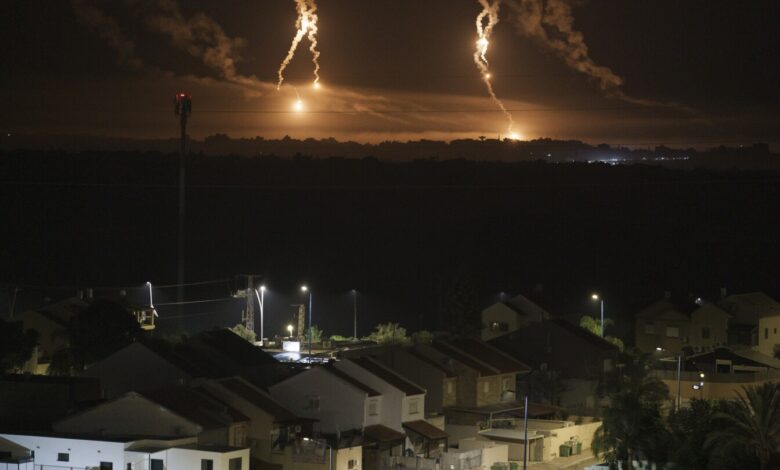Israel-Hamas war: Internet, phone networks collapse in Gaza

KHAN YOUNIS, Gaza Strip (AP) — Internet and telephone services collapsed across the Gaza Strip on Thursday for lack of fuel, the main Palestinian provider said, bringing a potentially long-term blackout of communications as Israel signaled its offensive against Hamas could next target the south, where most of the population has taken refuge.
Israeli troops for a second day searched Shifa Hospital in the north for traces of Hamas. They displayed what they said were a tunnel entrance and weapons found in a truck inside the compound. But the military has yet to release evidence of a central Hamas command center that Israel has said is concealed beneath the complex. Hamas and staff at the hospital, Gaza’s largest, deny the allegations.
The military said it found the body of one of the hostages abducted by Hamas, 65-year-old Yehudit Weiss, in a building adjacent to Shifa, where it said it also found assault rifles and rocket-propelled grenades. It did not give the cause of her death.
The communications breakdown largely cuts off Gaza’s 2.3 million people from each other and the outside world, worsening the severe humanitarian crisis in southern Gaza, even as Israeli airstrikes continue there. The U.N.’s World Food Program warned of “the immediate possibility of starvation” in Gaza as the food supply has broken down under Israel’s seal and too little is coming from Egypt.
The war, now in its sixth week, was triggered by Hamas’ Oct. 7 attack into southern Israel in which the militants killed over 1,200 people, mostly civilians, and captured some 240 men, women and children. Weiss, the woman whose body was found Thursday, is the third hostage confirmed dead, while four others have been freed and one rescued.
Israel responded to the attack with a weekslong air campaign and a ground invasion of northern Gaza, vowing to remove Hamas from power and crush its military capabilities.
More than 11,470 Palestinians have been killed, two-thirds of them women and minors, according to Palestinian health authorities. Another 2,700 have been reported missing, believed buried under rubble. The official count does not differentiate between civilian and militant deaths, and Israel says it has killed thousands of militants.
Fifty-six Israeli soldiers have died during the ground offensive.
The war has inflamed tensions elsewhere. In the occupied West Bank, Palestinian gunmen opened fire at a checkpoint on the main road linking Jerusalem to Israeli settlements, killing a soldier and wounding three people.
The three attackers were killed, according to police, who said the assailants had assault rifles, handguns and hatchets, and were preparing an attack in Jerusalem. Hamas claimed responsibility for the attack.
SOME GUNS, BUT SO FAR NO TUNNELS
A day after storming into Shifa, Gaza’s largest hospital, Israeli troops continued searching the complex. Gaza’s Health Ministry said the troops searched underground levels of the hospital Thursday and detained technicians who run its equipment.
The hospital has not had electricity for nearly a week, and staff say they have been struggling to keep alive 36 premature babies and 45 dialysis patients without functional equipment.
One dialysis patient died Thursday, Shifa’s director, Mohamed Abu Selmia, told Al Jazeera, adding that 650 wounded patients and 5,000 displaced people are in the hospital.
Israel said its soldiers brought medical teams with incubators and other supplies, though Shifa staff said incubators were useless without fuel. Gaza’s Health Ministry said 40 patients, including three babies, died before the raid after the emergency generator ran out of fuel Saturday.
During previous days of fighting in the nearby streets, there was no report of Hamas fighters firing from inside Shifa, and no fighting when Israeli troops entered Wednesday.
Israel faces pressure to prove its claim that Hamas set up its main command center in and under the hospital, which has multiple buildings over an area of several city blocks. So far, it has mainly shown several caches of weapons.
On Thursday, the military released video of a hole in the hospital courtyard it said was a tunnel entrance. It also showed several assault rifles and RPGs, grenades, ammunition clips and utility vests laid out on a blanket that it said were found in a pickup truck in the courtyard. The Associated Press could not independently verify the Israeli claims.
For years, Israel has depicted the hospital as the site of a major Hamas headquarters. In recent weeks, it released satellite maps that specified particular buildings as a command center or as housing underground complexes. It released a computer animation portraying a subterranean network of passageways and rooms filled with weapons and fuel barrels. The U.S. said it has intelligence to support Israeli claims.
The allegations are part of Israel’s broader accusation that Hamas uses Palestinians as human shields across the Gaza Strip — which Israeli officials say is the reason for the large numbers of civilian casualties during weeks of bombardment.
LOOKING SOUTH
The military says it has largely consolidated its control of the north, though fighting continues there. Defense Minister Yoav Gallant said Wednesday the ground operation will eventually “include both the north and south. We will strike Hamas wherever it is.” He did not give a time frame.
Israeli forces dropped leaflets Wednesday afternoon telling Palestinians in areas east of the southern town of Khan Younis to evacuate. Similar leaflets were dropped over northern Gaza for weeks ahead of the ground invasion.
Strikes continued in the south Thursday. In the city of Deir al-Balah, a funeral was held for 28 people killed in an overnight bomb that leveled several buildings.
Most of Gaza’s population is crowded into southern Gaza, including hundreds of thousands who heeded Israel’s calls to evacuate to the north to get out of the way of its ground offensive. Some 1.5 million people driven from their homes have packed into U.N. shelters or houses with other families.
If the assault moves into the south, it is not clear where they would go, as Egypt refuses to allow a mass transfer onto its soil. The Israeli military has called on people to move to a “safe zone” in Mawasi, a town on the Mediterranean coast a few square kilometers (square miles) in size, where humanitarian aid could be delivered.
The heads of 18 U.N. agencies and international charities on Thursday rejected the creation of a safe zone, saying that concentrating civilians in one area while hostilities continue was too dangerous. They called for a cease-fire and unimpeded entry of humanitarian aid and fuel for Gaza’s population.
Israel has sealed off Gaza since the start of the war, allowing only a trickle of aid from Egypt. It also bars delivery of fuel, saying it will be diverted to Hamas — though it allowed a small amount this week for U.N. trucks to use in delivering aid.
The World Food Program said the 447 trucks that have brought food into Gaza from Egypt — out of 1,129 relief trucks total since Oct. 21 — provide less than 7% of the population’s daily caloric needs. Bread is “scarce or non-existent” after fuel shortages shut down most bakeries, and food supply chains have collapsed, it said.
“With winter fast approaching, unsafe and overcrowded shelters and the lack of clean water, civilians are facing the immediate possibility of starvation,” said WFP Executive Director Cindy McCain.
Lack of fuel also brought down the internet and phone network, and it can’t be restarted unless Israel lets in fuel, said Palnet, the main Palestinian telecoms provider. That raises the potential for a long-term communications blackout, after three earlier shutdowns that Gaza authorities were able to repair.
The previous blackouts traumatized Palestinians, leaving them unable to call ambulances or reach family members to ensure they are alive. Aid workers say the shutdowns wreak havoc on humanitarian operations and hospitals. Some Palestinians manage to keep up communications using satellite phones or SIM cards that reach Israeli or Egyptian networks.
___
This story corrects that Israel began dropping leaflets calling for Palestinians to evacuate areas east of Khan Younis Wednesday, not Thursday. ___
Jeffery and Keath reported from Cairo. Associated Press writers Amy Teibel and Melanie Lidman in Jerusalem; Najib Jobain in Khan Younis, Gaza Strip; and Kareem Chehayeb in Beirut contributed to this report.
___
Full AP coverage at https://apnews.com/hub/israel-hamas-war.



